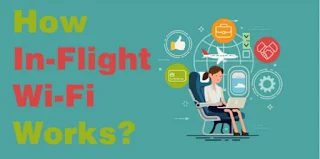The craze of the internet is spread everywhere, from tea shops to bus terminals, train stations to airport lounges; it is a basic necessity of life. However, the craze hasn’t reached to the skies. We are still waiting a day when we will start using internet cheap and fast in-flight. Many airlines are adding this service to their carriers including the google flights and the list of airlines is expanding every other day. Some are giving their frequent flyer a roaming service for their national telecom companies as a part of their cheap flight's service while others are giving few MBs for free.
The internet in the airplane is there, but unlike the fast internet connections like charter internet deals on the ground level, it is still unreliable. Because of its snail-paced speed and non-steadiness. It arises in one’s mind that how the internet in airplane works and we it is so slow. What are the technical difficulties which hindering the speed and steady internet on an airplane?
In this article, you will see in-depth details of how the internet Wi-Fi works on the airplane. There are two types of in-flight Wi-Fi, tower-based, and satellite-based. We will discuss these two types below.
Ground tower internet
I was traveling once on the SkyTeam member “Saudia” airplane from Riyadh to Istanbul on their Airbus A330 airliner. An internet Wi-Fi and mobile service were given to the passenger on this flight. Basically, they were providing internet to their customers by making contracts with different on-ground network providers and made it commercial through roaming internet packages according to their local roaming services, It was slightly good in speed, but it was very expensive and limited plus it only worked when was plane is flying over the land areas.
When internet Wi-Fi was first time introduced on aircraft, it was powered with on the ground cell towers like GoGo services. Usually, antennas are connected to the base of the fuselage of the plane, which sends and receive the signals from on-ground towers of telecom companies. As you travel into different sections of airspace, the plane automatically connects to signals from one tower to another tower, so in process of reconnecting to a different tower, there is a slight interruption or complete restart of the connection. This connection gives the high-speed internet but the main drawback of this type of internet is, it doesn’t work if the plane is taking ocean or sea route or over the remote terrain.
Satellite internet
The second form of technology is satellite technology. The technology works very similarly to the geostationary satellite internet (except the airplane is moving object). The airplane connects to the nearest geo satellite, which sends and receives signals to via transmitters attached to the plane. Information is transmitted to and from your Wi-Fi device to the top of the aircraft transmitter, which connects to the closest satellite signal. Wi-Fi signal is distributed to plane passengers through an on-board router.
Satellite internet
The second form of technology is satellite technology. The technology works very similarly to the geostationary satellite internet (except the airplane is moving object). The airplane connects to the nearest geo satellite, which sends and receives signals to via transmitters attached to the plane. Information is transmitted to and from your Wi-Fi device to the top of the aircraft transmitter, which connects to the closest satellite signal. Wi-Fi signal is distributed to plane passengers through an on-board router.
 |
Why is in-flight Wi-Fi so slow?
Technology is developing fast, but it has struggled to keep up with the complexity and a sheer number of Wi-Fi devices. Back in 2008, when in-flight broadband company Gogo, launched its first onboard Wi-Fi service on a Virgin America plane, the 3 Mbps connection was satisfactory for few. But now, with every passenger carrying at least one device to connect to innumerable applications that need internet, websites, and services, there’s a much greater strain on resources.
These days, a satellite connection offers around 8 Mbps, but satellites are expensive to maintain and upgrade, that’s why the internet connection transmission is slow with this technology. So we can’t depend on it and we are still lagging behind in the race for good internet from the on-ground connection.
Why is in-flight Wi-Fi so expensive?
All of that technology doesn’t come cheap and nor do the in-aircraft systems. Antennas also increase drag, adding fuel costs to the airline’s expenses. Those fees, plus engineering and maintenance costs are usually passed on to customer’s tickets.
Gogo, meanwhile, currently has a monopoly on US in-flight Wi-Fi, with a network that covers the whole country. It has been criticized for its painfully-slow upload and downloads speeds, but its new 2Ku service promises upgraded antennas and satellite services, delivering up to 50 Mbps almost as half the speed of Spectrum Internet and faster than the other on-ground services.





